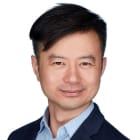Commentary: Why Nvidia CEO Jensen Huang is the most unexpected tech rockstar
Jensen Huang, the Taiwan-born founder of semiconductor giant Nvidia, brings a quiet determination to a Silicon Valley known for hype and bluster, says IMD Business School’s Howard Yu.


This audio is generated by an AI tool.
LAUSANNE, Switzerland: At 61, Nvidia CEO Jensen Huang is not your usual Silicon Valley tech rockstar. Meta CEO Mark Zuckerberg achieved stardom before age 30, as did Bill Gates and Steve Jobs. This week, Nvidia overtook Microsoft and Apple to become the world’s most valuable company, at about US$3.34 trillion.
It’s not like Nvidia builds products that consumers can easily relate to: Unlike iPhones or Facebook, most of us never directly buy or even see Nvidia’s graphics cards or artificial intelligence chips.
Yet, fans mobbed Mr Huang at the Computex tech trade show in Taiwan earlier this month and flocked to the restaurants and night market stalls he patronised. “Jensanity” has swept the island and the tech world.
So how did Mr Huang become the “Taylor Swift of tech”, as coined by Mr Zuckerberg?
NAVIGATING US-CHINA GEOPOLITICAL RISKS
For one, Taiwan-born Mr Huang has arguably become the face of the AI semiconductor boom, at a time when chips have become the next front in the rivalry between China and the United States.
One of the deepest fault lines lies in Taiwan which is at the heart of everything technological that powers Silicon Valley to Shenzhen. It holds the key to the world’s digital future.
“Taiwan is the unsung hero, a steadfast pillar of the world,” Mr Huang said onstage at Computex, pointing to a chart that showed 100 Taiwanese companies, such as TSMC. The semiconductor foundry manufactures most of the world’s advanced chipsets, including Nvidia’s most advanced AI chips.
Foxconn, Quanta, Pegatron and Wistron assemble Apple, Dell and HP products. Delta Electronics enables the power and thermal management of electric vehicles and data centres. ASUS is known for its high-performance personal computers and components.
Washington wants to contain China. Beijing wants to achieve self-sufficiency. And Taiwanese companies, knowing both sides need them, play cute.
Make friends with everyone. Take orders from Apple’s Tim Cook, Amazon’s Jeff Bezos, Tesla’s Elon Musk, Alibaba’s Jack Ma and Xiaomi’s Lei Jun. Why choose? Hedge your risks. Only the paranoid survive.
THINK WORKHORSE, NOT UNICORN
Looking at its success today, it is easy to forget that it took Nvidia wandering in the wild for 30 years before striking gold. It’s no overnight unicorn.
Its first chip was a massive flop. Its second was doomed to fail: Japan’s Sega had contracted Nvidia to develop a new game console using an unconventional 3D rendering approach. Microsoft subsequently announced a competing standard, which ultimately was adopted by the rest of the industry. Nvidia instead pivoted to build a compatible Graphics Processing Unit (GPU) that accelerated the performance under the emerging Windows standard.
Then, in 2006, Nvidia discovered that its graphics cards could do more than make pictures and videos. They could accelerate other fast, repetitive tasks - ideal for areas like machine learning. To tap this potential, the company released CUDA.
Programming GPUs directly is complex. CUDA made it much easier by providing a set of tools that anyone could use to write code and use GPUs. Nvidia then poured at least US$10 billion into CUDA, according to their numbers from back in 2017.
CUDA was already a game changer and here’s the kicker: CUDA was free. In one fell swoop, anyone with programming skills could experiment.
And everyone did - from Tesla to Sony and Amazon, from students at Berkeley to MIT. Machine learning, artificial intelligence and scientific computing were big winners from widespread experimentation. That’s how OpenAI and Meta became Nvidia’s biggest customers.
It was a huge and risky leap at the time into what Mr Huang now calls a “zero billion dollar” AI market. He understood that Nvidia needed to be more significant in the age of AI to develop new applications around machine learning.
THE REALISM OF JENSEN HUANG
But far more than one who has risen from rags to riches, Mr Huang is the embodiment of persistence and realism, rather than just raw talent.
He was the awkward immigrant who endured a gauntlet of hardships during his childhood. He credits his first job at a fast food restaurant for helping him learn the value of efficiency and hard work.
He had realistic expectations of himself and what Nvidia could achieve within a limited time. “People with very high expectations have very low resilience, and unfortunately, resilience matters in success,” he said in March at his alma mater Stanford. He even went as far as wishing “ample doses of pain and suffering” upon the students, believing these experiences to be essential for personal growth and success.
Ultimately, the world is tired of loud-mouthed Silicon Valley leaders who overpromise and underdeliver. They pretend to save humanity, dream of space travel and throw money at trying to live forever.
Jensen Huang isn’t interested - he’s busy building more advanced GPUs to enable others to dream big.
His quiet but steady determination is refreshing in an industry known for its hype and bluster. This grounded approach has endeared him to fans, Wall Street, and notably, to his own employees.
When was the last time we saw such a craze for Mr Zuckerberg or Mr Cook?
Howard Yu is the LEGO® Professor of Management and Innovation at IMD business school in Switzerland and serves as Research Director of the Center for Future Readiness.


















